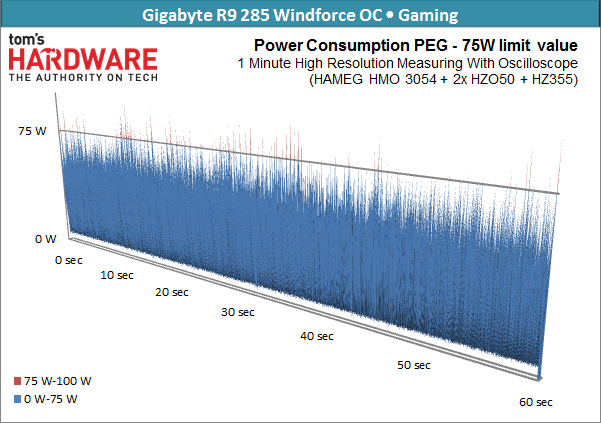AMD Radeon R9 285 Review: Tonga and GCN Update 3.0
On paper, the new Tonga-based R9 285 looks to be slightly slower than the R9 280 it is intended to replace, but there's more than meets the eye.
Why you can trust Tom's Hardware
Gaming Power Consumption Results
Power Consumption: Gaming Loop
For the gaming lop measurements we firstwarm up the graphics card for 20 minutes until a stable GPU temperature of 64 degrees Celsius has been reached. At this point we proceed to measure the card’s power consumption again. Our gaming loop is relatively challenging for the GPU, so we’re confident that the average 176 W we measured is a good representation of today’s demanding game engines. less demanding titles should draw between 165 to 170 Watts depending on the particular title, of course.
Once again, lets focus on just one minute of the smoothed curve. This shows us that the way the load is distributed between the PCIe and the motherboard power connectors conforms to the applicable norms.
The control exercised at the motherboard slot is reassuring. There’s never a sustained load that exceeds the slot’s maximum 75 Watt rating.
Let’s take a look at how the 176 W of power consumption while gaming are split in the table.
| Header Cell - Column 0 | Minimum | Maximum | Average |
|---|---|---|---|
| PCIe 12V | 33 W | 209 W | 124 W |
| Motherboard 3.3V | 3 W | 7 W | 5 W |
| Motherboard 12V | 9 W | 93 W | 47 W |
| Graphics Card Total | 47 W | 290 W | 176 W |
List of All Individual Values per Supply Line
Again, we’ve put together all power consumption values for each supply line in a handy gallery.




Voltages
The average voltage is exactly 12 V, just like it was at idle. However, the fluctuations are present and accounted for as well.
The Gigabyte R9 285 WindForce OC and its 176 W for gaming comes in almost 40 W lower than a moderately overclocked AMD Radeon R9 280 reference graphics card, which also provides slightly lower performance on average. When we referenced the Gigabyte R9 285 WindForce OC’s efficiency on the graphics cards in our 2014 VGA charts, it looks like it’s comparable to Nvidia’s older Kepler-based GeForce GTX 760. If winning the efficiency war was the goal, then it most certainly hasn’t been reached, but at least AMD was able to catch up. This probably won’t be enough to compete with Maxwell, though.
Get Tom's Hardware's best news and in-depth reviews, straight to your inbox.
Current page: Gaming Power Consumption Results
Prev Page Idle Power Consumption Results Next Page GPGPU Power Consumption ResultsDon Woligroski was a former senior hardware editor for Tom's Hardware. He has covered a wide range of PC hardware topics, including CPUs, GPUs, system building, and emerging technologies.
-
JeanLuc The idle power consumption numbers are odd, the previous generation cards use less then at idle didn't they? Not that 15 watts is going to break anyone's bank account but its strange nether the less.Reply
Good to see AMD have tackled the noise and temperature issues that have plagued it's previous 28nm cards as well but it's a bit late in the day given that 20nm shouldn't be to far off now. -
gear999 Really nice article guys. I'm impressed by how the 285 actually was able to keep up with the 280. And I'm shocked by the fact that The $250 Nvidia card loses to a $170 AMD card. Thank god I bought a GTX 770 :PReply
Also, on the last page, you guys wrote R7 270X instead of R9, and in the chart it says "Relative to Radeon HD 7950 Boost". Oh, and in the Pros section, it says the 285 has R9 260 like performance?
Thanks for the proofread, fixing it now! :) -
Mike Stewart wow ! at 250$ it actually is a better card even than 280X !! and it was meant for 760....but as it shows here even a 270X is a WAY better card than 760....Reply -
tomfreak Had the tonga 285 come with a 6GHz/7Ghz GDDR5 & 4GB VRAM, the result will be a lot different. Whats with AMD putting on a 5500 memory? facepalm.jpgReply -
srap While this is really a third GCN iteration, showing it as a version number of 3.0 (as in: "Tonga and GCN Update 3.0") makes no sense for me.Reply -
Amdlova some one write this with a .45 acp on the head. I see some error on numbers models etc...Reply
I prefer get a r9 280 and downclock get same results. I can't see the point of this heat on graphics. maybe drivers. OR THIS IS HAWAII XT! Too much Heat! -
Amdlova ReplyI wanted to see the GPU die and OCing results. :(
I think the guys see if they hit the OC the room Will burn! maybe a problem with drivers.
Last time i see that Heat 290x tests. lol! -
Gillerer On the first page, it says "Improvements are always welcome but with the memory interface cut in half compared to the Radeon R9 280,...".Reply
But in fact, the memory interface was cut by a third (384 bit -> 256 bit), not half.
Good point, fixed! Thx.





